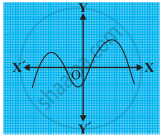Advertisements
Advertisements
Question
The number of polynomials having zeroes – 3 and 4 is ______.
Options
1
2
3
more than 3
Solution
The number of polynomials having zeroes – 3 and 4 is more than 3.
Explanation:
The number of polynomials having zeroes – 3 and 4 are infinite or more than 3.
Required polynomials = (x + 3) (x – 4)
= x2 – x – 12
Now, we can check that any other quadratic polynomial that fits these conditions will be of the form k(x2 – x – 12).
Where k is real.
APPEARS IN
RELATED QUESTIONS
The graphs of y = p(x) are given in following figure, for some polynomials p(x). Find the number of zeroes of p(x), in the following.

The graphs of y = p(x) are given in following figure, for some polynomials p(x). Find the number of zeroes of p(x).

Find the zeroes of the polynomial `f(x) = x^2 ˗ 2x ˗ 8` and verify the relation between its zeroes and coefficients
If f(x) =`x^3-3x+5x-3` is divided by g(x)=`x^2-2`
If ∝ and β are the zeros of the polynomial f(x) = `6x^2 + x - 2 `find the value of `(∝/β+∝/β) `
Given that one of the zeroes of the cubic polynomial ax3 + bx2 + cx + d is zero, the product of the other two zeroes is ______.
If x3 + 11 is divided by x2 – 3, then the possible degree of remainder is ______.
If the graph of a polynomial intersects the x-axis at exactly two points, it need not be a quadratic polynomial.
The zeroes of the quadratic polynomial x2 + kx + k, k ≠ 0 ______.
The graph of y = f(x) is shown in the figure for some polynomial f(x).

The number of zeroes of f(x) is ______.
